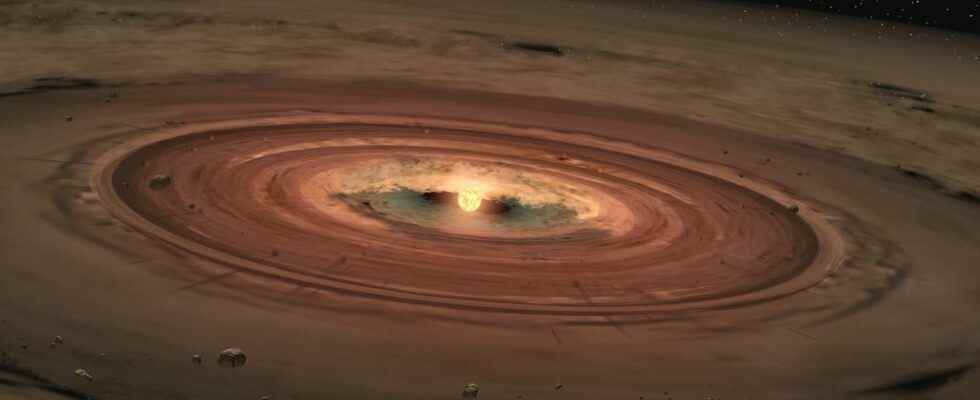We know it, the Solar system formed about 4.5 billion years ago, from the protoplanetary disk that surrounded our young star. The gas and the dust that composes it gradually accreted with each other, forming larger and larger bodies: first planetesimals, then protoplanets, and finally planets. Not all rocks fuse together, as evidenced by the asteroid belt which houses many fragments and small rocks. To trace the exact course of this process, the researchers analyze asteroids primitive, almost intact remnants of the early Solar System, as demonstrated by a study recently published in the journal Nature Astronomy.
Fossils from the birth of the solar system
Some asteroids came crashing down on the Earth only a few thousand years after it was formed, and then contain precious traces of our past. “Previous scientific studies have shown that asteroids in the Solar System have remained relatively unchanged since their formation billions of years ago”, explains Alison Huntfirst author of the study and researcher at ETH Zurich. “So they are an archive, in which the conditions of the early solar system are preserved. »
A. Hunt and his team thus analyzed asteroid nuclei having landed on Earth almost 4 billion years ago. Specifically, these are samples of 18 meteorites of iron, extracted from the metallic cores of asteroids. They then dissolved each sample, with the aim of establishing isotopic abundances for the palladiumI’silver and the platinum. Indeed, during the first million years of the Solar System, these asteroid nuclei were heated by radioactive decay, in particular creating a specific isotope of silver from palladium, which then accumulated during cooling. . By measuring its ratio among the other elements, it is possible to know when this cooling began, but also at what speed it happened. And the results showed, consistent with previous studies, a rapid cooling due to numerous collisions: they exposed the core of the asteroids to the freezing vacuum of space. But what the study brings new is the moment when this cooling occurred.
“Our additional measurements of platinum isotope abundances allowed us to correct silver isotope measurements for distortions caused byirradiation cosmic samples in space. So we were able to date the timing of collisions more accurately than ever before.explains A. Hunt. And to our surprise, all of the asteroid nuclei we examined were exposed almost simultaneously, within 7.8 to 11.7 million years after the Solar System was formed. » Indeed, taking platinum into account has enabled researchers to quantify the influence of cosmic rayswhich can alter the ratio of silver isotopes: they have thus drastically reduced their uncertainties.
Chaotic beginnings for the Solar System
Recall that the Solar system is more than 4.5 billion years old: thus, a range between 7.8 and 11.7 million years represents only a short moment in its history. A particularly unstable moment, according to the researchers. “Everything seems to have collapsed at that timeasks A. Hunt. And we wanted to know why. ». Several hypotheses could explain this period: these are numerical simulations who have decided. “The theory that best explained this first energetic phase of the Solar System indicated that it was mainly caused by the dissipation of the solar nebula”says Maria Schönbächler, co-author of the study and professor of cosmochemistry at ETH Zurich. “This solar nebula is the remnant of gas that was left behind by the cloud cosmic from which was born the Sun. For a few million years it still revolved around the young Sun until it was swept away by the winds and solar radiationshe adds.
In fact, stars are formed by collapse gravity of a cloud of gas called a nebula. But not everything collapses: a part of it remains which gravitates around the recently formed core, which will then become the famous protoplanetary disk. At beginning of the solar systemthis disk was particularly dense: but as the Sun lit up, more and more solar winds accompanied by radiation were emitted. These winds “blew” a large part of the dust isolated from the disc, making it less and less dense and reducing the drag of the objects that compose it. All the rocky bodies would then have accelerated, and would then have started the famous unstable phase. “Our work illustrates how improvements in laboratory measurement techniques allow us to infer key processes that took place in the early Solar System – such as when the solar nebula was likely to disappear. Planets like Earth were still being born at that time. Ultimately, it can help us better understand how our own planets came to be, but also give us insight into others outside of our Solar System.”concludes Schönbächler.
Special offer: for Father’s Day, offer the best of Science!
Your father is a great science enthusiast and unusual discoveries? And if you offer him a superb scientific exploration in paper format? Benefit from -20% on the Mag Futura (special offer: €15 instead of 19 €): 220 pages to explore 4 scientific issues that will shape our future!
Mag Futura is:
- 4 major scientific questions for 2022, from the Earth to the Moon
- 220 pages, 60 experts: no fake news, just science
- Home delivery with electronic gift card
- An independent scientific media
Interested in what you just read?
